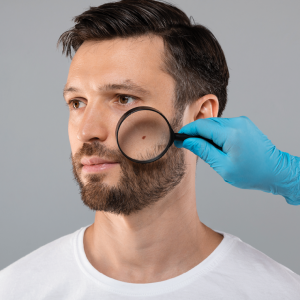Skin Cancer And Melanoma Prevention
THE SKIN CARE EDITION
Skin Cancer And Melanoma Prevention
In Australia, we should always be reminded of the dangers
of overexposure to the sun and the associated risks of skin cancer and melanoma.

What Is Skin Cancer?1
Skin cancer occurs when skin cells grow abnormally to form a tumour in the skin and is usually caused by prolonged and repeated exposure to ultraviolet (UV) radiation in sunlight. It is the most common form of cancer with nearly 1 million new cases treated every year. Although most skin cancers are preventable and can be successfully treated if detected early, there is no cure.
What Is Melanoma?
Melanoma is one of the three main types of skin cancer. Although the rarest type of skin cancer accounting for only 2 per cent of cases, melanoma is considered the most dangerous form2.
Initially confined to the top layer of skin, if left untreated it can quickly spread through the deeper layers where it can enter the lymphatic system and blood stream. From this stage it can travel to almost any part of your body, especially the lymph nodes, lungs, liver, and brain. When this spread occurs it can also arise on areas of the skin that are not exposed to the sun. Upon spreading, treatments for melanoma are not always effective3.

Melanoma Facts and Statistics4
It is expected that 16,000 people will be diagnosed with melanoma this year with Australia having the highest rates of diagnosis in the world. One person diagnosed every 30 minutes. Unfortunately, it is estimated that 1,300 people will die from melanoma in Australia this year, as it is the most common cancer affecting Australians between the age of 20 and 39 years of age.
It is estimated that 1 in 17 Australians will be diagnosed with melanoma during their lifetime, 1 in 14 men and 1 in 24 women5. Although dependent on type, size, location, and spread, more than 90 per cent of melanoma cases can be successfully treated with surgery if detected early6.
What Causes Skin Cancer and Am I At Risk?
Although more common if you are older, everyone is at risk as we are all exposed to the sun. There are several factors that can increase the risk of developing melanoma. These include7:
• Unprotected sun exposure during childhood and adolescence
• History of tanning and use of sun beds
• Repeated sunburn from working, playing sport or leisure time in the sun
• High number of moles / irregular moles
• Family history of melanoma or previous cancer
• Fair or freckled skin, red or fair hair, blue eyes, or skin that burns easily.
How Much Sun is Enough?9
UV radiation from sunlight is both a major cause of melanoma and the best natural source of vitamin D. Some sun exposure is important for vitamin D production to maintain body health, strong muscles, and bones. For most people, adequate vitamin
D levels can be achieved by spending only a few minutes outdoors throughout the week when the UV index is low. Be sensible and use sun protection when outdoors to balance maintaining adequate vitamin D levels.
Talk to your doctor if you are concerned about your vitamin D levels and if required, your pharmacist for a suitable vitamin D supplement.
Download the SunSmart app for information on the UV index and when sun protection is needed in your local area. Sunsmart.com.au/ resources/sunsmart-app
CAN SKIN CANCER BE PREVENTED?
Skin cancer and melanoma can be prevented. Checking your skin regularly will increase the chance of early detection, whilst avoiding sunburn and placing greater emphasis on sun protection can reduce your risk of developing melanoma. Protect your skin and reduce your risk by following these simple tips8:
Seek shade – Stay out of the sun during the middle of the day (10am – 4pm) when UV index is high.
UV levels are highest in summer, late spring and early autumn, but are not dependent on temperature or cloud cover. Cold and cloudy summer days still have high UV levels.
Wear protective clothing
– Cover your shoulders, neck, arms, legs, and back. Wear a wide-brimmed hat.
Apply a broad-spectrum sunscreen – SPF of 50+. Make sure you cover all exposed skin and re-apply regularly, after swimming or exercise.
Slide on sunglasses – Ensure they wrap around your face to protect your eyes and skin.
Examine your skin regularly
– Become familiar with your skin and moles. Check for differences in size, shape, colour, and borders. Seek help for signs of change or bleeding and itching.
Have a professional check
– GP or skin specialist can and should examine your skin thoroughly at least once a year if you are at high risk.
Stay away – Do not use sun lamps, solariums, or sunbeds.
Talk to your pharmacist about the best sun protection available for you.
References
1. Skin cancer and melanoma 2021, healthdirect, Australian Government Department of Health, viewed 22 February 2022, <healthdirect.gov.au>.
2. ibid.
3. What is melanoma? 2021, Australian Melanoma Research Foundation, viewed 22 February 2022, <melanomaresearch.com.au>.
4. Understanding Melanoma 2022, Melanoma Institute Australia, viewed 22 February 2022, <melanoma.org.au>.
5. Fast facts about melanoma 2021, Australian Melanoma Research Foundation, viewed 22 February 2022, <melanomaresearch.com.au>.
6. ibid.
7. Am I at risk? 2021, Australian Melanoma Research Foundation, viewed 22 February 2022, <melanomaresearch.com.au>.
8. Melanoma Prevention and Early Detection 2022, Melanoma Institute Australia, viewed 22 February 2022, <melanoma.org.au>.
9. ibid.